The FOYERs were cordially invited to NHB's "exclusive celebratory private party" - By the Light of the Lanterns - at Hua Song Museum. I RSVPed, in anticipation of
Hua Song (华颂) means "in praise of the Chinese" and is the world's first visitor centre dedicated to the story of all the overseas Chinese. It is located in the new wing of Haw Par Villa, so for the price of one admission ticket you get to visit two attractions - the theme park and the museum. But did I mention the theme park is free entry all day?
At The Survivors exhibition gallery, many Madame Tussauds - like figures greet us, like the man with shiny forehead in the cover photo.
We learnt how the Chinese contributed to America's economy by laying railway tracks. Many gave their lives as well (see photo).
Chinese labourer laying a standard-gauge track. 10 miles of track was laid on April 20, 1869. (Contrast with the first railway track laid in Malaya in 1885 and only 8 miles)
Females also contributed to the economy, unfortunately as commodities in child trafficking transactions. Young girls were sold as bondmaids (Mui Tsai, 妹仔) for .. can you guess the price? Look for the answer in my photo.
Left: A Prostitute in Chinatown USA.
Right: Fictitious newspaper reporting historical events. Thanks to police and missionaries, some of the girls were emancipated.
Their more glorious story is told in Hollywood star Anna May Wong (黃柳霜), the first Chinese American movie star.
Paying homage to the great Anna May Wong. Can you see the puppy beside her?
Truly, the gallery does a good job in educating the public on the plight and contributions of the Chinese in America.
Beside life-sized figures, I also find the food and beverages interesting. Sometimes you see fruits in crates and even drink dispensers. They look just like the real thing.
A provision shop you can see and touch. I wanted to scoop some hay-bi (dried shrimp) but was thwarted - they are non-removable from the sack.
A ginseng-chrysanthemum tea dispenser. I forgot to try whether the tap works.
If you are hungry, head down to their exhibits - En En's Kitchen and Grand Food Hall. In the former, I found a dissected snake on the kitchen chopping board. The chopper is removable and when I brought it for closer examination, I found wet entrails stuck on the blade and a funny smell lingering. Eat snake, anyone? Still hungry?
If you paid for the tickets, you would be greeted by a lone migrant at the entrance. I did not, so I found him last. The party included a "free" and "easy" tour of the museum, so I could start anywhere I want. This migrant is representative of our Chinese ancestors. Regardless of what they did, whether railroad workers or coolies, they first carried their barang-barang and walked the long road from village to dock.
"The Long Road, a philosophical display representing the uncertainties felt by migrants who left their home villages for new opportunities overseas" (museum website).
Ticketing entrance. The ghostly person in the background is our lone migrant.
Do head down to Hua Song if you wish to know more about the overseas Chinese story. The showcase are engaging, with Madame Tussauds - like experience and if you have kids, they'd enjoy the indoor playground at the Popular Culture exhibit.
Once again, I thank NHB and Hua Song for organizing the mid-autumn party and giving me the chance to tour the museum FOC.
(This is not the end, by the way. Part II is here, where I blog about the party itself.)
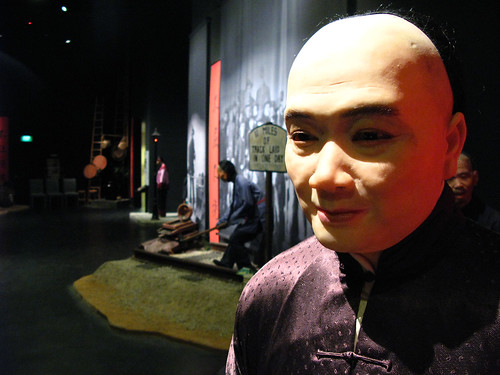

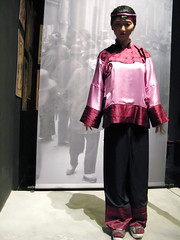
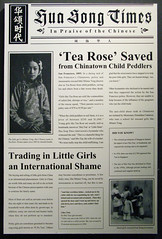
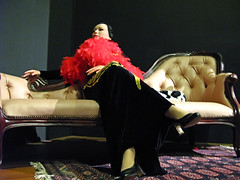
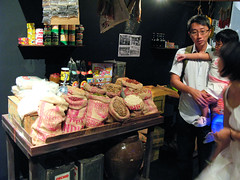

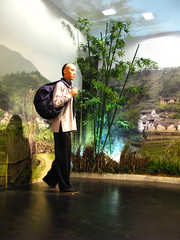
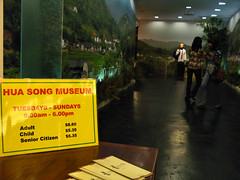
Thanks for the virtual tour, Icemoon. Saved me a trip.
ReplyDeleteYou are welcome, Victor.
ReplyDeletei got freaked out for a second by the shiny forehead man.
ReplyDeleteHe looks real, if you ask me.
ReplyDeleteIt's interesting to read the different things that people blog about for this same event and the photos they took. One common attraction was the caligrapher.
ReplyDeleteI did not take photos of the calligrapher. The party will be my next post. So what will I blog about?
ReplyDeleteI must say you have great photography skills. :)
ReplyDeletePY, I practise with my dolls. :)
ReplyDeleteUnfortunately I don't have great riddle skills, that you can read in Part II here.
The Cantonese were ravaged by wars and wasted by opium. The men were lured by promises of gold in California, but recruited to build the Transcontinental Railroad. From the mining fields of the Gold Coast, Australia, to the fur-trading outposts of Nootka Sound, Canada, most Chinese indentured laborers were from Guangdong Province. They were exempted from the migration ban because the Treaty of Nanjing compelled the Qing Government to legalize the coolie trade. But since women and children were not granted immunity from punishment if they migrate, their families were forced to stay behind.
ReplyDeleteThe Minnan term for enslaved servant is "Char Boh Kan". The Cantonese term is "Nou Pei". Owned by the wealthy in feudal China, "Char Boh Kan" or "Nou Pei" were children of the poor. They were often resold, since they were chattel.
However, "Mui Tsai" was the word used in the sex traffic. "Mui Tsai" is pronounced as mue-a or be-a among the Hokkiens and the Teochews, and they address the younger girls in their family as mue-a or be-a. Destitute Cantonese parents, in their hardest hours of grief, were comforted by the folly that their daughters were sold for adoption into wealthy, benevolent homes in Shantou (Swatow).
source:
http://books.google.com.sg/books?id=pSJ2BgAAQBAJ&printsec=frontcover#v=onepage&q&f=false
Thanks Anonymous for the informative comment on coolie trade and Mui Tsai.
ReplyDelete